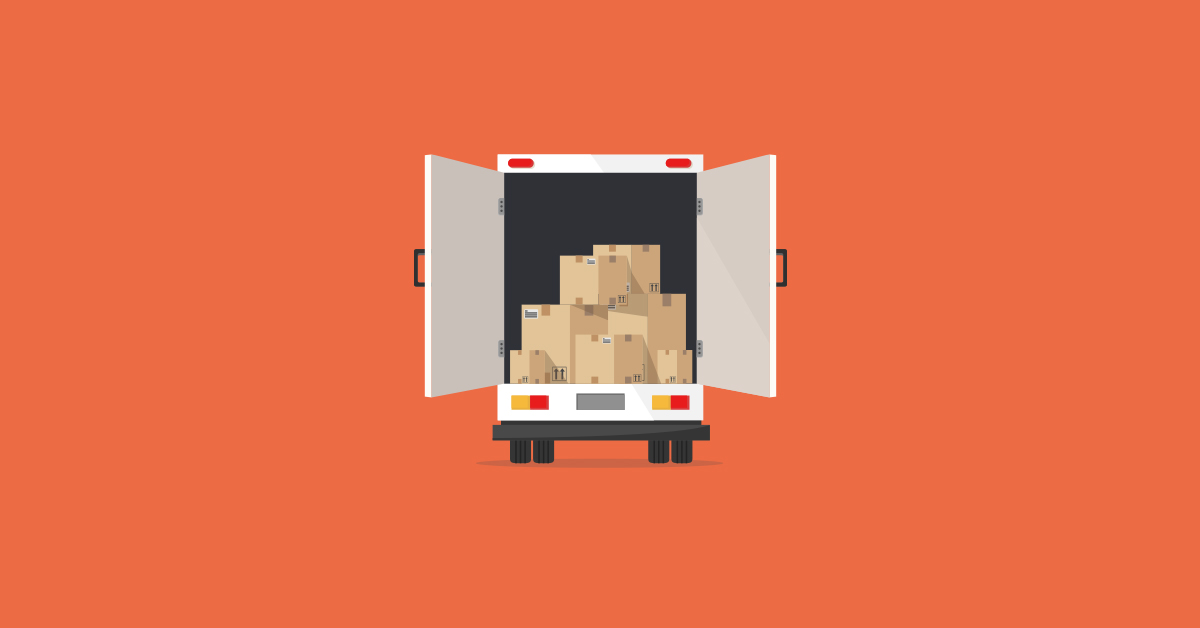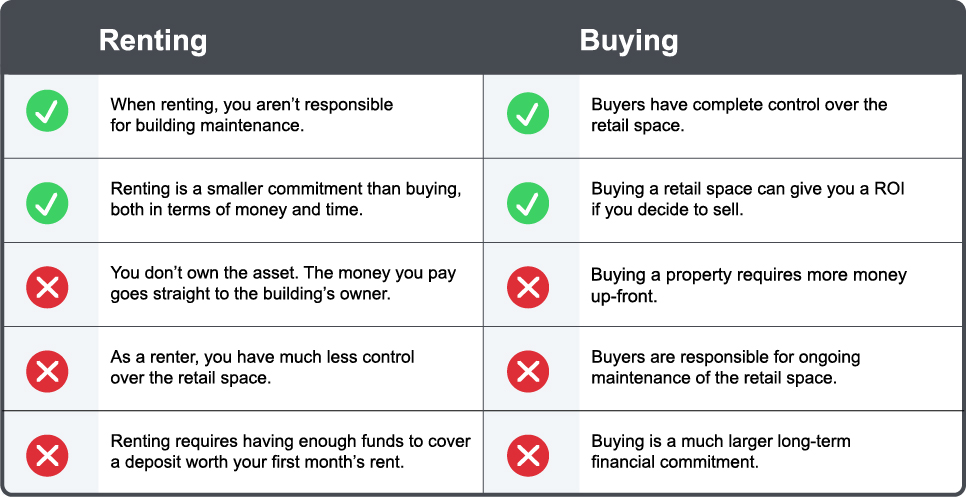
Are you thinking of opening a new store? Whether it’s your first store, or you already manage multiple locations, you should know a few things before going further.
Should you rent or buy? How much square footage do you need? Does the area attract a decent amount of foot traffic? There are many different factors to consider before you get started. So, we’re going to cover everything you need to know before you start looking. Let’s get started.
In this post, we’ll cover:
- What is a retail space?
- What are the benefits of having a retail space?
- How to find a retail space
- What are the pros and cons of renting vs. buying?
Manage inventory, customers, and employees, ring up sales, and run everything behind the scenes with Lightspeed ePOS for Retail: the complete eCommerce platform designed for the modern retailer.Your ePOS system is the heartbeat of your store
What is a retail space?

A retail space is a physical location where retailers sell products and services to customers. They can exist virtually anywhere where there are customers to serve: shopping centres, bustling metropolitan areas, suburbs, and even temporary pop-up shops.
Retail spaces are different from other commercial spaces in that they’re built to optimise the flow of customers and allow customers to walk freely through the space and browse products.
Note: Some retailers opt to set up shop near “anchor stores” which are highly-popular stores that generate lots of foot traffic for the nearby area. For example, an Apple store would be an anchor store, as people will often travel to an area with an Apple store specifically to visit it. Retailers opt to set up their shops nearby as they can benefit from the increased foot traffic.
What are the benefits of having a retail space?
You’ll likely already know what a retail space is, and probably have some idea of why it’s a good idea to have one for your business. But, there are a few specific benefits to opening a physical retail store instead of just relying on a web store.
In fact, rather than stifle its growth, eCommerce has propelled retail to new heights and introduced new ways for merchants to engage with, sell to, and serve consumers.
1. Opportunity
Customers who engage with sales associates tend to spend more than those who don’t. The NBA Store in New York saw conversions increase by 182% when customers engaged with a sales associate. In fact, in a report conducted by PWC, they found that 82% of consumers crave more human interactions in the retail experience.
And, while online shopping has plenty of tricks to increase a customer’s basket size, like free shipping thresholds and suggested add-on items, what you can’t get is an interpersonal connection. eCommerce is strictly transactional, not experiential.
2. Build a brand
A retail space can act as a potent form of marketing. For digital-first brands like Glossier, they saw opening a retail space as an opportunity to curate a completely on-brand, customer-centric experience from the moment they walk in.
“The retail stores are a calculated, true representation of the Glossier brand and what the experience should be,” says Ali Weiss, Glossier’s SVP of Marketing. “We definitely take risks, but we analyse how it will impact the consumer experience before we do anything.”
Glossier fans don’t visit the flagship store just to buy products. They can easily do that online. They visit to see the immersive experience that Glossier curates, and local customers stop by to pick up orders more quickly than they would be shipped out if they had ordered online.
3. Customer experience
The main advantage that physical retail stores have over online stores is that it enables a brand to create their ideal customer experience and control it from end to end. If you’re using physical retail as an experiential touchpoint with your target market it can help you differentiate yourself from competitors.
Plus, when you sell directly to consumers through your own retail store, you have access to a rich catalogue of consumer data and feedback that you can use to improve your products, services, processes and customer service.
When customers feel like you value their opinion and use it to actively make improvements, they’re far more likely to make repeat purchases, sign up to your customer loyalty programme, recommend your products and services to friends and family, and be your biggest fans on social media.
How to fund your business expansion
Opening a new store is easier said than done. Saving the money to reinvest into your business so you can scale can take a lot of time, and securing financing through traditional loans can create an unnecessary amount of stress and anxiety around paying the loan off. What if there was a better way of funding your business? Introducing Lightspeed Capital.
Lightspeed Capital allows you to grow your store, maintain cash flow, and finance new projects with flexible funding for your business. Capital isn’t a traditional loan, it’s a cash advance program designed for merchants. Unlike traditional loans, you pay what you borrowed as you go, and only when you make sales. No fluctuating interest rates or hidden costs. Just a simple flat-fee payment structure with no scheduled monthly payments. Plus, you can have your cash advance deposited into your bank account as soon as two business days.
Want to learn more about how you can grow your business with Lightspeed Capital? You can find everything you need here.
How to find a retail space

Once you’ve committed to opening a physical retail store, finding the perfect retail space to set up shop is the next step. While it can be time-consuming, it’s best to take your time here and assure that your location fits all of your criteria and your budget.
Here are five steps to finding the perfect retail space:
- Pinpoint your needs
- Identify your ideal location
- Find an estate agent
- Inspect each potential retail space
- Negotiate your rent/purchase price
1. Pinpoint your needs
Before you start your search, try to have a clear idea of what type of retail space you want. For example, if you’re a clothing store, you want to factor in having enough space for changing rooms. If you’re a bike shop, you’ll want space for a repair shop. In most instances, a good retail space should have space to set up product displays to lure passers-by.
Here are other factors you need to need to consider:
Location: The area where you decide to set up shop has a massive impact on your sales. Try scoping areas where your target demographic lives, where the store can benefit from more foot traffic, and where there are other businesses you can partner with, send customers their way and vice versa.
Accessibility: Consider how easy it is for customers to get to a location. Ideally, you’re accessible by public transport and/or by car. For retailers who sell large items, like home furniture stores, parking should also be a top consideration. Additionally, if you plan to offer curbside pickup, make sure you have ample space in front of your store to do so.
If your customers find it difficult to visit your store, it’s safe to assume in most cases, they won’t.
Square footage: How much space do you need? Better yet, how much space can you afford without taking on too much overhead? Research the cost per square foot of stores that you admire, or even some of your competitors, and see how much space they have. You should also take into consideration how much inventory you have too. You can use these factors as a benchmark to start from when you start looking.
Budget: Once you know how much square footage you need and how much that typically costs, you need to set a budget and stick to it. There’s no sense in taking on a retail space you can’t comfortably afford.
Consider using accounting software, or hiring a financial adviser with retail experience, to get your finances in order and forecast how much you can spend on rent or a mortgage per month while still turning a profit.
Utilities: Depending on the type of business you open, you should try and estimate how much your utility costs would be. For example, if you’re opening a pet store and plan on offering pet grooming and bathing services, having utilities included at a fixed rate could be advantageous.
2. Identify your ideal location
When scoping out potential retail locations, it’s best to first identify which location you see yourself opening up shop. When pinpointing potential neighbourhoods, consider these factors:
- Consider your target market: Who is your target market, and where do they live? Ideally, you open your store where there’s a high concentration of the people you aim to serve.
- Average cost: How much do commercial spaces with your ideal square footage cost in your ideal neighbourhoods? Do your research and eliminate neighbourhoods that fall out of budget to further narrow the scope of your search.
- Crime rates: Eliminate commercial spaces located in areas with high crime rates. Not only do they put you at a greater risk of theft, but it can also reduce foot traffic and lead to higher marketing expenditures.
- Small business community: Is there a community of small businesses in that area? Forging partnerships with other SMBs is a great way for each business to attract and share like-minded customers and mutually succeed as a result.
- Competitors: Are there other businesses in your desired area that fulfil the same niche and target a similar clientele? There’s nothing wrong with a bit of competition. But, the more fierce the competition, the more difficult it will be to attract and retain customers.
- Additional expenses: Depending on the location, in addition to basic utilities, you may need to pay for lawn maintenance, security, cleaning services and waste disposal services. Some of these services may be included, so it’s best to ask so you have a definite idea and can budget accordingly.
3. Find an estate agent
While finding a retail space on your own is an option, it’s not ideal, especially if you don’t have any past experience. We suggest hiring an estate agent with experience in the retail industry to help you find a great location within your budget, negotiate a favourable rate and complete the transaction of the property with the landlords.
4. Inspect each potential retail space
Once you and your estate agent have a list of potential locations that fit your needs and budget, you need to inspect each space and carefully vet your options. What are your must-haves, nice-to-haves, and deal-breakers?
During each inspection, consider the following things:
- Parking: Do you need parking? Is there street parking, a nearby car park, or on-site parking available?
- Visibility: Is the neighbourhood well-known, up-and-coming, or out of the way? Other than the neighbourhood, how is the actual retail space’s visibility? Does it stand out? Is it likely to attract passers-by, or is it hidden away?
- Condition: How is the condition of the space? Will you need to take on any major or minor renovations to get it ready? Factor that into your budget to see if the retail space is still worth pursuing.
- On-site amenities: Is there a dressing room, bathroom, back of house, office, or any other amenities you consider necessary?
- Merchandising displays: Does the retail space come equipped with shelving and merchandising displays, or do you need to build and install them yourself?
- Size: Is the space big enough? Do you have enough room to comfortably fit inventory, employees and customers? Do you have enough space for a fixed cash register or should you save space by investing in a mobile electronic point of sale system to process transactions? If you’re in the market for an ePOS for your retail space, why not consider Lightspeed ePOS for Retail? You can find everything you need to know right here.
5. Negotiate your rent/purchase price
Before you sign anything, make sure to consult a solicitor who specialises in commercial properties. They can review the mortgage/rent agreement, bring any red flags to your attention, and make sure the deal is in your best interests.
What are the pros and cons of renting vs. buying?
What’s the best option: leasing or buying a commercial retail space? Here are the pros and cons of each:

When it comes to deciding whether you should rent or buy a retail space, there is no universal right answer. It all depends on your budget, your needs and your preferences.
Find the right commercial retail space for you
Where you choose to set up shop is no small decision; it’s a huge factor in the success of your brick-and-mortar operation.
While it’s to be expected that your retail space, you still want your projected revenue to rent ratio (also known as the occupancy cost) to be manageable. After you deduct the cost of goods sold (your inventory costs or raw materials you purchased) and labour expenses, you still want enough revenue leftover to cover rent and leave money in the bank.
Ultimately, you don’t want your retail space to cost too much money. Unless there’s a very strong reason for paying more in rent (fewer renovations or located in a far safer neighbourhood, for instance), it’s better to opt for the less expensive option. The less you spend on rent, the more funds you have for advertising, paying your employees, reinvesting in the business and, of course, keeping for yourself.
Looking for software to help you streamline your in-store purchases and online orders? Talk to one of our retail experts to see how Lightspeed ePOS for Retail can accommodate your customers however they decide to purchase from you.

News you care about. Tips you can use.
Everything your business needs to grow, delivered straight to your inbox.


